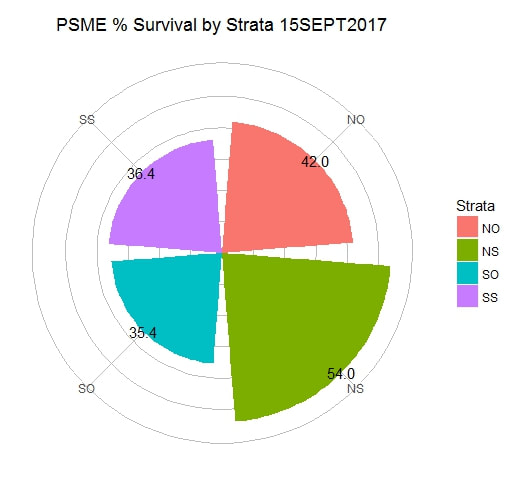|
In a previous post about this project I recounted the trials and tribulations of elk eating our seedlings. Fortunately they didn’t get them all. We’ve been following these seedlings all summer to learn how survival varies as a function of aspect and vegetation cover. As a refresher on a previous post, we hypothesized that seedlings would be more likely to survive on north facing slopes and under the cover of shrubs, rather than out in the open on south facing slopes. The reason being that south facing slopes without shrub cover would be hot, dry, and stressful for seedlings. What are we finding so far… Well, it depends. Douglas-fir is what we call a more shade-tolerant species, meaning it can tolerate lower light environments when it is a seedling. As of 15 September, this species had the highest survival on north facing slopes and under the cover of shrubs. Ponderosa pine tends to be more shade intolerant, meaning it prefers a higher light environment. In this case we found that south aspects, regardless of shrub cover and north aspects with shrub cover all had 64-66% survival. North aspects without shrub cover had 76% survival. This suggests that they are getting the light they need, but are benefiting from it being a little cooler and moister on the north facing aspects without shrub cover. Pinyon pine, which is a species that grows at lower elevations and tends to regenerate in the shade of adult trees and shrubs is a bit of a mystery right now. It had higher survival on south facing slopes without shrubs and on north facing slopes with shrubs. We’re going to have to keep following this species and dig into the temperature and relative humidity data to figure out what is going on. Southwestern white pine is a species that tends to be intermediate in terms of shade tolerance, similar to Douglas-fir. This species also tends to occur at higher elevations in the Jemez with Douglas-fir because it requires more precipitation. These seedlings did best on north facing slopes, growing under shrub cover. Interestingly, it did better on south slopes in the open than it did on north slopes in the open. This result is another head-scratcher that is going to require digging into the data. We are nearing the end of the first growing season for these seedlings that we planted last fall. We’ll keep tracking these individuals to see how they do during the next growing season and we’ll be planting some new sites this fall. So, stay tuned for more results from our experiment trying to understand tree seedling establishment in a severely-burned landscape.
0 Comments
|
Details
Archives
October 2023
Categories
All
|





 RSS Feed
RSS Feed